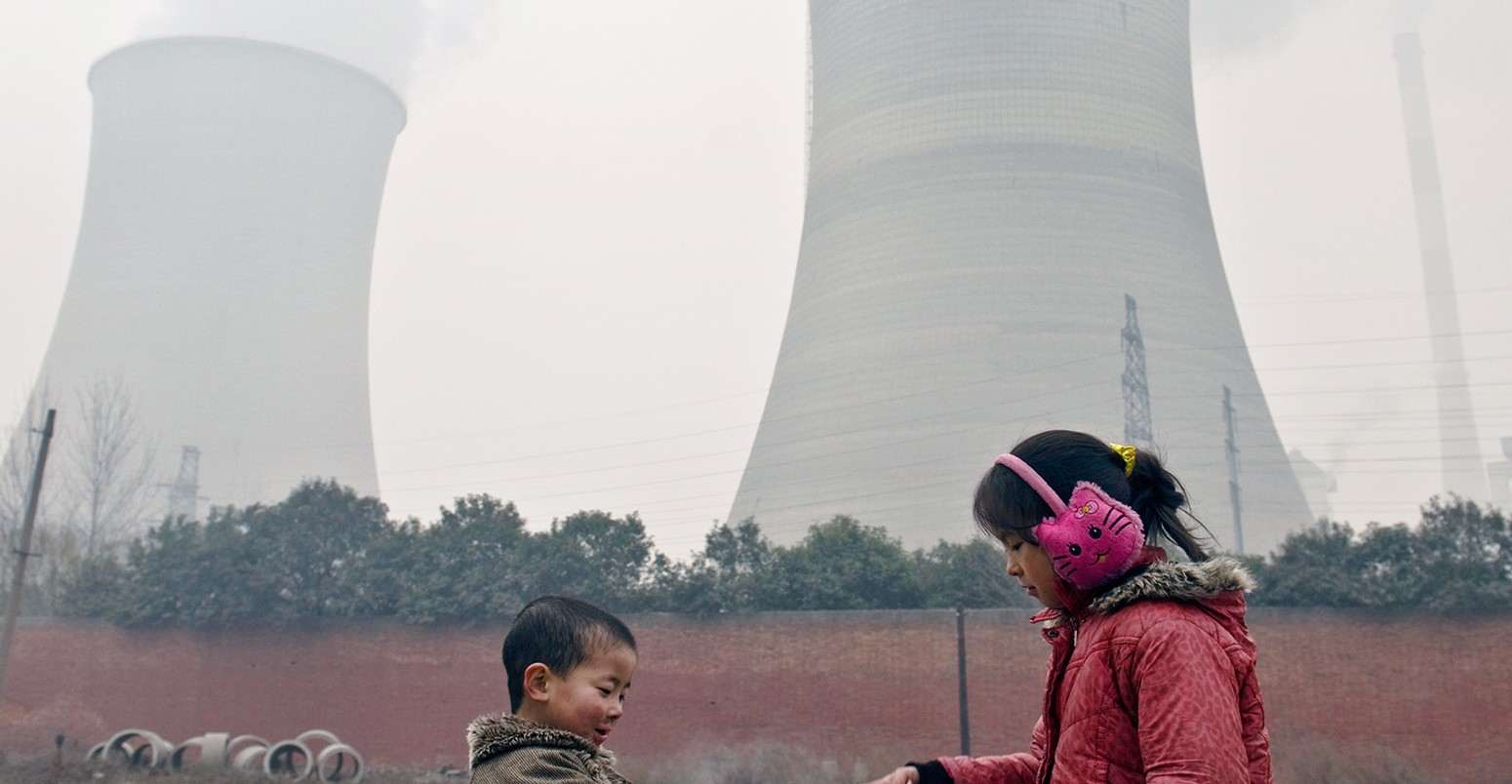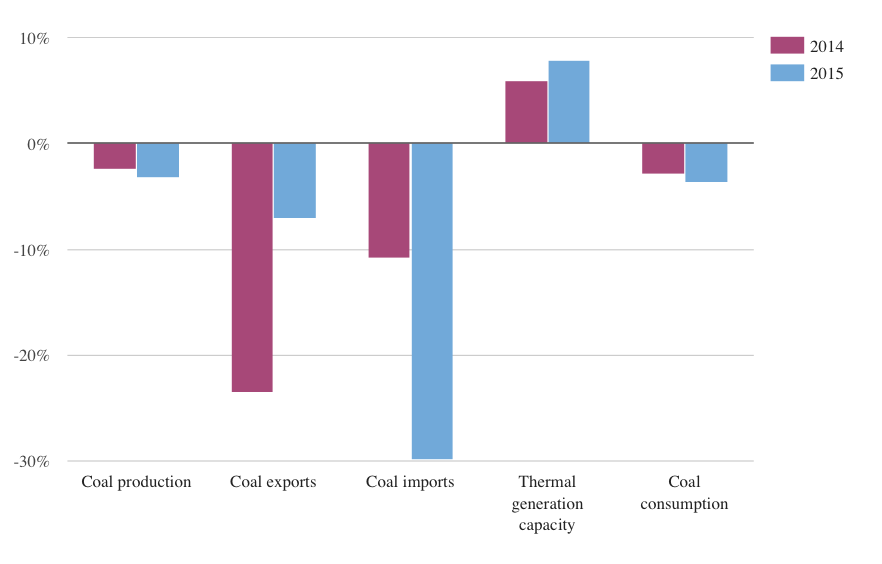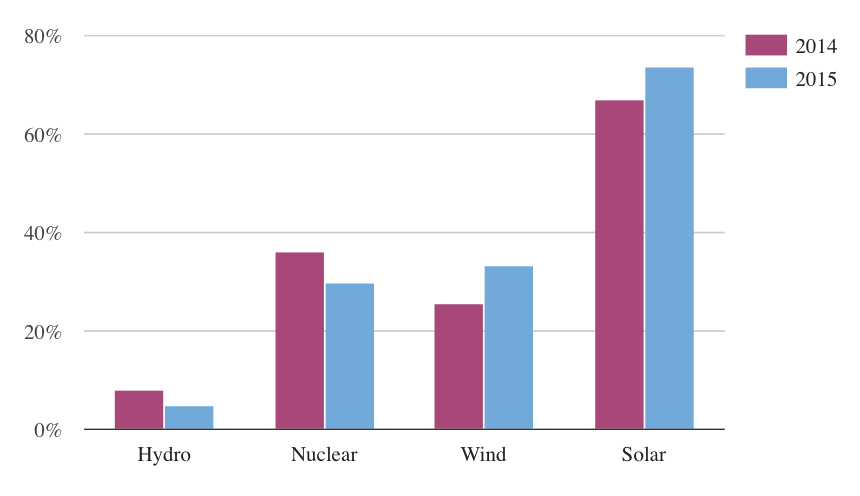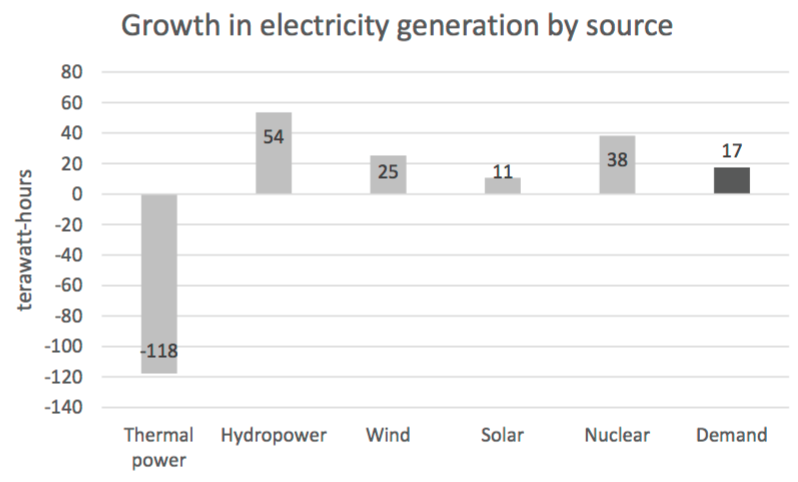
Analysis: Decline in China’s coal consumption accelerates
Sophie Yeo
02.29.16Sophie Yeo
29.02.2016 | 12:38pmChina’s coal use declined 3.7% in 2015, according to official statistics released by the Chinese government today.
This is the second year running that the consumption of China’s most polluting fuel has declined. What’s more, the reduction took place while the economy grew.

The data will raise hopes that coal use in the country has finally peaked.
The statistics reveal that the decline in coal is accelerating. In 2014, China’s coal use declined by 2.9%. The year before that, it increased by 3.7%, illustrating the country’s marked energy turnaround.
Meanwhile, renewables continued to grow, with solar capacity increasing by 74% in 2015, and wind by 34%.
According to Greenpeace analysis of the figures, this means that China’s CO2 emissions declined by 1-2% in 2015.
The role of coal
The significance of China’s coal use extends beyond its national borders. In particular, it is one of the major factors globally that determines progress in tackling climate change.
Responsible for 30% of total emissions, China is the world’s largest emitter. In 2014, it emitted about as much CO2 as the US, EU and India combined.
The majority of this pollution is tied to coal.
According to EU data, the fuel constitutes 73% of China’s fossil fuel consumption, and is responsible for 83% of the CO2 emissions that result from burning fossil fuels. This reflects its higher carbon intensity compared to oil and gas, where consumption continues to rise.
The data released today shows that coal is now responsible for 64% of China’s total energy consumption.
The Chinese government does not regularly release official estimates of domestic emissions. However, using other official data as a proxy, including coal and electricity consumption, other analysts have tried to calculate a figure on its behalf.
In 2014, as China’s coal use fell by 2.9%, studies variously found that Chinese emissions declined by 0.7%, or saw a small growth of 1.2% or 0.9%, depending on how analysts made the calculation. Recent revisions to China’s fuel consumption and pollution are testament to how notoriously difficult this undertaking can be.
Regardless of the precise figure, it should be obvious that this represents a dramatic slowdown from the first decade of the 2000s, when China’s emissions were increasing at a rate of around 10% per year.
As the largest emitter, trends in Chinese emissions visibly influence the global picture.
Alongside declining coal use and (arguably) declining Chinese emissions, 2014 was also a landmark year for global emissions.
At the same time as the global economy expanded, emissions almost stalled, rising by only 0.6%, according to a Nature paper, which Carbon Brief covered at the time. Estimates by the International Energy Agency (IEA) went even further, stating that global emissions actually did stall in 2014.
This contrasts to annual growth of around 4% for the past decade.
The decline across coal, Chinese emissions and global emissions appears to have not only repeated, but also accelerated, in 2015.
An early estimate published in Nature, based upon low Chinese coal consumption for the first eight months of the year, found that China’s emissions declined by 3.9% in 2015, with global emissions correspondingly shrinking by 0.6%.
This happened at the same time as Chinese and global economies grew by 6.9% and 2.4%, respectively, showing that it is possible to decouple economic growth from emissions.
Analysis by Glen Peters, a senior researcher at CICERO, of the statistics found that China’s CO2 emissions dropped by 1.9% in 2015, albeit with large uncertainties.
Chinese CO2 emissions in 2015 could be down 1.9%, with large uncertainty.
2015 data from https://t.co/ACaB115Je1 pic.twitter.com/2UjR6Zci9e— Glen Peters (@Peters_Glen) February 29, 2016
2015 statistics
There are other signs that China took a turn for the cleaner in 2015.
In 2015, total electricity consumption grew by 0.5%, according to official statistics, compared to growth of 3.8% in 2014.
The government attributes this to economic restructuring in China, as the country tries to replace its rapid boom with a more sustainable form of growth. This means, for the first time in 40 years, industrial electricity consumption shrunk, with demand shifting towards domestic consumption and services instead.
Not only did China consume less coal, it also produced, imported and exported less.
Coal also went from providing 66% of China’s energy consumption in 2014 to 64% in 2014 — at the same time as energy consumption rose overall by almost 1%.

The chart shows that China is continuing to expand its thermal generation capacity, which is mainly coal. Some have taken this as a sign that falling consumption is an anomaly, with the general trend still being upwards. Professor Boqiang Lin from the Institute for Studies in Energy Policy at Xiamen University said:
Yet this new capacity is not being used, and government policies are constraining their use in the future, which could create an “investment bubble” for coal plants and a missed opportunity for renewables, Greenpeace analysis suggests.
Renewables, nuclear, oil and natural gas stepped in to fill the gap. Consumption of crude oil rose by 5.6%, natural gas by 3.3% and electric power by 0.5%. The installed capacity of renewables and low-carbon forms of energy also increased across the board, with growth in wind and solar outstripping the pace of growth seen in the previous year.

Greenpeace has also looked at changes in how much energy was generated, in addition to how much additional capacity was installed.

Lauri Myllyvirta, senior global campaigner on coal at Greenpeace, explained his findings to Carbon Brief:
In total, “clean energy” consumption (which includes nuclear and natural gas) accounted for 17.9% of total energy consumption in 2015, an increase of 1% on the previous year.
China vs climate change
A decline in coal is not only beneficial for China, but also for the world.
It undermines the arguments of those who still claim that inaction on climate change from China excuses other countries from acting.
For this decline is not just due to economic restructuring. It is also down to a raft of climate change measures that are curbing China’s carbon emissions and the heavy smog, christened an “airpocalypse” by some, that has made daily life hazardous for residents of China’s most polluted cities.
By 2020, China has pledged to cut air pollution emissions from coal-fired power plants by 60%, saving around 180m tonnes of CO2 each year in the process. According to China Daily, Beijing has declared it will “wipe out” coal use in its most rural areas.
It also wants to reduce the carbon intensity of its economy by 40-45% on 2005 levels. China has suggested it might “far surpass” this. Today’s statistics show that the amount of energy that is consumed in China per unit of GDP dropped again by 5.6% in 2015, on top of the 4.8% drop seen in 2014.
In addition, China has said that coal should be reduced to below 62% of primary energy by 2020. With today’s statistics showing that coal dropped in 2015 to 64% of total energy consumption, China looks to be on track to achieving this.
It recently announced that it will restrict new coal-fired power plants, refuse to approve any new coal mines for three years, and will aim to close more than 1,000 mines over the course of 2016.
China also has longer term targets, pointing towards 2030, made as part of its contribution towards the UN climate deal reached last year in Paris.
This includes promises to peak its CO2 emissions by 2030 at the latest, lower the carbon intensity of its GDP by 60-65% below 2005 levels and increase the share of non-fossil fuels in its energy mix to around 20% by the same year.
Peak coal?
In the world of climate change, pinnacles are not always neat. It is difficult to say definitively whether China has peaked coal as what goes down can also go up.
This has been the case for US emissions, which continue to fluctuate, and also Japan’s, which have been on the rise again since 2009.
According to the IEA, it is “feasible” that China already passed peak coal in 2013.
But, regardless of fluctuations, the combination of real world evidence and governmental policy makes it clear that the future’s not bright for the coal industry — while the sun continues to rise on China’s chance for hitting the climate targets it set itself in Paris.

